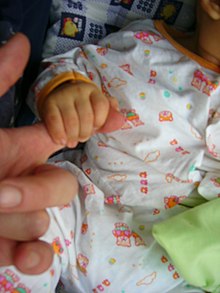|
Reflex
In biology, a reflex, or reflex action, is an involuntary, unplanned sequence or action[1] and nearly instantaneous response to a stimulus.[2][3]  Reflexes are found with varying levels of complexity in organisms with a nervous system. A reflex occurs via neural pathways in the nervous system called reflex arcs. A stimulus initiates a neural signal, which is carried to a synapse. The signal is then transferred across the synapse to a motor neuron, which evokes a target response. These neural signals do not always travel to the brain,[4] so many reflexes are an automatic response to a stimulus that does not receive or need conscious thought.[5] Many reflexes are fine-tuned to increase organism survival and self-defense.[6] This is observed in reflexes such as the startle reflex, which provides an automatic response to an unexpected stimulus, and the feline righting reflex, which reorients a cat's body when falling to ensure safe landing. The simplest type of reflex, a short-latency reflex, has a single synapse, or junction, in the signaling pathway.[7] Long-latency reflexes produce nerve signals that are transduced across multiple synapses before generating the reflex response. Types of human reflexesAutonomic vs skeletal reflexesReflex is an anatomical concept and it refers to a loop consisting, in its simplest form, of a sensory nerve, the input, and a motor nerve, the output. Autonomic does not mean automatic. The term autonomic is an anatomical term and it refers to a type of nervous system in animals and humans that is very primitive. Skeletal or somatic are, similarly, anatomical terms that refer to a type of nervous system that is more recent in terms of evolutionary development. There are autonomic reflexes and skeletal, somatic reflexes.[8] Myotatic reflexesThe myotatic or muscle stretch reflexes (sometimes known as deep tendon reflexes) provide information on the integrity of the central nervous system and peripheral nervous system. This information can be detected using electromyography (EMG).[9] Generally, decreased reflexes indicate a peripheral problem, and lively or exaggerated reflexes a central one.[9] A stretch reflex is the contraction of a muscle in response to its lengthwise stretch.
While the reflexes above are stimulated mechanically, the term H-reflex refers to the analogous reflex stimulated electrically, and tonic vibration reflex for those stimulated to vibration. Tendon reflexA tendon reflex is the contraction of a muscle in response to striking its tendon. The Golgi tendon reflex is the inverse of a stretch reflex. Reflexes involving cranial nerves
Reflexes usually only observed in human infants Newborn babies have a number of other reflexes which are not seen in adults, referred to as primitive reflexes. These automatic reactions to stimuli enable infants to respond to the environment before any learning has taken place. They include:
Other kinds of reflexesOther reflexes found in the central nervous system include:
Many of these reflexes are quite complex, requiring a number of synapses in a number of different nuclei in the central nervous system (e.g., the escape reflex). Others of these involve just a couple of synapses to function (e.g., the withdrawal reflex). Processes such as breathing, digestion, and the maintenance of the heartbeat can also be regarded as reflex actions, according to some definitions of the term. GradingIn medicine, reflexes are often used to assess the health of the nervous system. Doctors will typically grade the activity of a reflex on a scale from 0 to 4. While 2+ is considered normal, some healthy individuals are hypo-reflexive and register all reflexes at 1+, while others are hyper-reflexive and register all reflexes at 3+.
Depending on where you are, another way of grading is from –4 (absent) to +4 (clonus), where 0 is "normal". Reflex modulation Some might imagine that reflexes are immutable. In reality, however, most reflexes are flexible and can be substantially modified to match the requirements of the behavior in both vertebrates and invertebrates.[10][11][12] A good example of reflex modulation is the stretch reflex.[13][14][15][16] When a muscle is stretched at rest, the stretch reflex leads to contraction of the muscle, thereby opposing stretch (resistance reflex). This helps to stabilize posture. During voluntary movements, however, the intensity (gain) of the reflex is reduced or its sign is even reversed. This prevents resistance reflexes from impeding movements. The underlying sites and mechanisms of reflex modulation are not fully understood. There is evidence that the output of sensory neurons is directly modulated during behavior—for example, through presynaptic inhibition.[17][18] The effect of sensory input upon motor neurons is also influenced by interneurons in the spinal cord or ventral nerve cord[16] and by descending signals from the brain.[19][20][21] Other reflexesBreathing can also be considered both involuntary and voluntary, since breath can be held through internal intercostal muscles.[22][23][24] HistoryThe concept of reflexes dates back to the 17th century with René Descartes. Descartes introduced the idea in his work "Treatise on Man", published posthumously in 1664. He described how the body could perform actions automatically in response to external stimuli without conscious thought. Descartes used the analogy of a mechanical statue to explain how sensory input could trigger motor responses in a deterministic and automatic manner. The term "reflex" was introduced in the 19th century by the English physiologist Marshall Hall, who is credited with formulating the concept of reflex action and explaining it scientifically. He introduced the term to describe involuntary movements triggered by external stimuli, which are mediated by the spinal cord and the nervous system, distinct from voluntary movements controlled by the brain. Hall's significant work on reflex function was detailed in his 1833 paper, "On the Reflex Function of the Medulla Oblongata and Medulla Spinalis," published in the Philosophical Transactions of the Royal Society, where he provided a clear account of how reflex actions were mediated by the spinal cord, independent of the brain's conscious control, distinguishing them from other neural activities.[25][26][27] See also
References
|